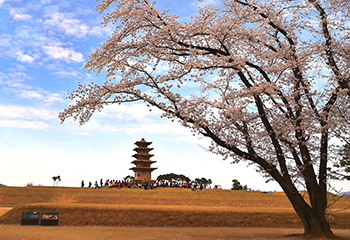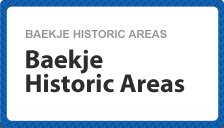Archaeological Site in Wanggung-ri
The Archaeological Site in Wanggung-ri located in Iksan, Jeollabuk-do, was built as a detached palace by the royal court of Baekje in an attempt to make up for the weakness of the capital city in Sabi (Buyeo). This site was created on the low hilly land at the foot of the ridge stretching from Yonghwasan Mountain. The land for the detached palace was leveled by cutting high sections and raising low-lying ones with earth. The external part of the spot where palace walls were installed was cut into a slope so that the inside of the royal palace was in excess of three to four meters higher than outside the palace wall. This formation was intended to make the central segment higher than the rest, and was intended to have the structures built on the high building site enough to present a grander appearance from outside.

The integrity of the Archaeological Site in Wanggung-ri was verified through archeological studies carried out over three decades starting in 1976. The site is composed of facilities related to the royal palace of Baekje, workshop facilities that produced gold and glass ob
Palace Wall
The walls built to protect the palace form a rectangular shape measuring 492.8m long in the east, 490.3m long in the west, 234.1m long in the south, and 241.4m long in the north. The width of each wall is 3 to 3.6m. The ancillary facilities include water gates, a stone drainage path, a culvert, and four doors. The structure, as identified from the southern section of the east wall, has two layers of stonework, of which only 1m remains, and a tiled roof placed on top of the stone work. According to archaeological investigations, the interior space of the palace had building sites related to ceremonial rites and governing offices to the south, and a rear garden, resting area, and craftsman’s workshop to the north.
The royal palace was meticulously designed with proportions of 2:1 and 1:1. The ratio between the distances from north to south(492.8m, 490.3m) and from east to west (234.1m, 241.4m) is 2:1, while the inside of the royal palace was divided into a southern section and northern section in the equal ratio of 1:1. This arrangement, where the core residential areas were located in the south and the rear garden was in the north of the royal palace, is also found in ancient royal palaces in China and Japan. The Archaeological Site in Wanggung-ri showed that ancient kingdoms in East Asia were actively engaged in sharing the principles and techniques for the construction of royal palaces.
Stoneworks
A progression of stoneworks was constructed to secure surfaces level so that buildings could be situated. The interior of the palace was segmented in a particular ratio, and four east-west stoneworks and two north-south stoneworks have been discovered. For stonework, well-chiseled stone materials were piled up in an orderly manner and then filled with clay and rubble. Parts of these stoneworks, which measure approximately 2m high (6-7 layers), still remained. Four layers of stonework were laid out in the southern section to divide the space into four areas. The width of each stonework is 76.6m, 44.5m, 72.3m, and 45.7m respectively, from south to north, and their ratio is about 2:1:2:1.
In terms of the height of the stoneworks, the first east-west stonework is higher than the others, as it measures 2m and the others are 0.5 to 1m. The fact that the Archaeological Site in Wanggung-ri was constructed with the ratios of 2:1 and 1:1 for its area or space usage, suggesting systematic design from the beginning.
Large Building Site
The large building site, considered as the king’s official palace, was discovered right the first east-west stonework. It was the largest building site at this location (35m from east to west by 18.3m from north to south), similar to the large building site unearthed at the Archaeological Site in Gwanbuk-ri, Buyeo. It is located at the center of the palace, and a large space to view the central gate and buildings was secured by placing buildings as close to the first east-west stonework as possible. This architectural creation has been a multi-storied building similar to a king’s official palace.
Building Site on Tiled Platform
The building site on tiled platform once stood right in front of the third east-west stonework made of piled tiles. This type of platform was frequently found in the royal palaces and temple sites from the Baekje Period in the Buyeo area. A total of 36 units of building sites, besides these ones, have been verified at the Archaeological Site in Wanggung-ri.
Rear Garden
Facilities associated with the garden were found in the northern area of the royal palace. This garden was a miniature version of the surrounding natural scenery by using oddly formed rocks, rectangular stones, and river gravel. The water for the garden was stored in pond. The water system comprised a control system to manage and control the flow of the water, a culvert drain system to control the volume of the water tank, a system to collect the water that flowed out from the garden, an inlet facility, and a pavilion. A U-shaped water-hole was used for gathering the water that was supplied to the rear garden, in the north of the main garden.
Historical records indicate that the style of the Baekje’s gardens had a considerable influence on the development of Japanese gardens. As a garden in the royal palace from the Sabi Period was discovered at the Archaeological Site in Wanggung-ri, it was confirmed that China, the Baekje Kingdom, and Japan were closely engaged in exchanges of their garden cultures. Some of oddly formed rocks in the Archaeological Site in Wanggung-ri contain Chinese viewing stones, indicating the international nature of Baekje culture.
Workshop and Everyday Life Facilities
Many types of production-related archaeological finding, such as gold and silver ob
In addition, to the south of the workshop, three units of large toilet were found lying in a row from east to west. Among them, Toilet No. 1 is 10.8m long, 1.8m wide, and 3.4m deep. These large toilets seemed to be used by ministers or court servants living in the royal palace. This was the first large ancient toilets found in Korea as an important archeological discovery comparable with its counterpart in Japan.
Buddhist Temple Facilities
The Archaeological Site in Wanggung-ri was initially constructed as a royal palace, but this function was changed to that of a Buddhist temple in the 7th century. In the process, existing buildings were demolished to make way for the main constituents of a temple, including a pagoda, lecture hall, and prayer hall. There is disagreement in the academic field as to exactly when this shift was made at the Archaeological Site in Wanggung-ri.










